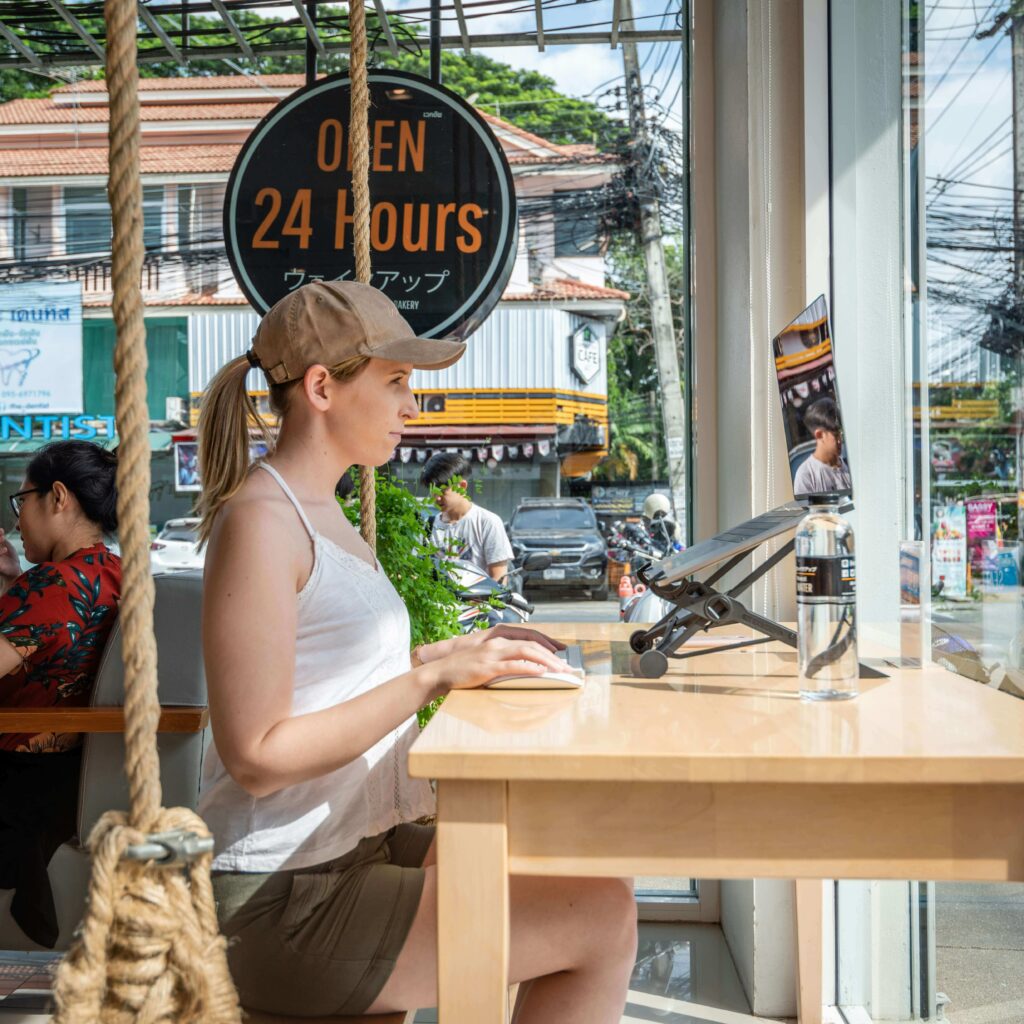Written by: Nila Patty Pelupessi
Picture this: A software developer sipping coffee at a beachside café in Bali, a content writer nestled in a medieval town in Georgia, and a marketing consultant joining a Zoom call from a co-working space in Medellín. Welcome to the digital nomad revolution - where work happens everywhere but the office.
The numbers are staggering: 80+ million digital nomads worldwide (more than the entire population of the UK), 50+ countries offering special nomad visas, and projections showing that by 2035, an astonishing 1 billion people will work remotely. This isn't just a trend—it's reshaping how we live, work, and travel.
But here's the burning question: As nomads hop from Lisbon to Chiang Mai to Mexico City, are they helping or hurting the places they temporarily call home? Enter Community Tourism – potentially the perfect partner in this global work-travel experiment.
When digital nomadism meets CBT, we're standing at a fascinating crossroads. Get it right, and we create a virtuous cycle of cultural exchange, economic fairness, and sustainable destinations. Get it wrong, and we face the ugly side: skyrocketing rents, cultural erosion, and communities that resent rather than welcome visitors.
Ready to discover how to be on the right side of this revolution? Let's explore the delicate dance between digital freedom and local responsibility - and why it matters more than you might think.
What is CommunityTourism ?
Community-Based Tourism (CBT) is more than just sightseeing. It’s a model where local communities lead tourism initiatives, ensuring that cultural heritage, traditions, and natural environments are preserved while economic benefits stay within the community.
Some key features of CBT include:
- Local ownership
Community tourism puts decision-making power directly in local hands. When community members own and operate tours, homestays, and cultural activities, they determine how their heritage is shared and at what price. This creates accountability, ensures authentic experiences, and guarantees that profits remain with those who created the value in the first place. - Cultural preservation
Rather than presenting watered-down versions of traditions, CBT invites visitors to engage with authentic cultural practices. From traditional weaving demonstrations to participating in seasonal harvest festivals or learning ancestral cooking techniques, these experiences help preserve cultural knowledge that might otherwise be lost to modernization, creating pride and renewed interest among younger community members. - Sustainable development
The community-centered approach means tourism revenue is democratically reinvested where it's needed most. Villages might use proceeds to build schools, improve healthcare facilities, install clean water systems, or fund environmental conservation initiatives. This creates a virtuous cycle where tourism directly improves quality of life while protecting the natural and cultural assets that attract visitors.
CBT has grown in regions from Latin America to Africa to Eastern Europe, offering travelers a richer and more responsible way to connect with their destinations.
Who Are Digital Nomads?
A digital nomad is anyone who uses technology to work remotely while traveling the world. This could be a software engineer in Lisbon, a freelance writer in Tbilisi, or a marketing consultant working from a café in Oaxaca.
Unlike short-term tourists, many digital nomads:
- Stay for weeks or months in one destination.
- Seek coworking spaces, reliable Wi-Fi, and community events.
- Spend more consistently on housing, food, and services.
Countries from Estonia to Costa Rica are actively courting digital nomads through special visas, hoping to capture their economic potential. But integration into local life depends on how nomads engage with communities—whether they stay in globalized bubbles or support local initiatives like Community Tourism.
Positive Impacts of Digital Nomads in Community Tourism Settings
When digital nomads engage thoughtfully, the potential benefits for CBT and local communities are significant:
- Economic Diversification – the presence of Digital Nomad allows smooth out of the local economy. Unlike short-term tourists, nomads often stay longer and spend steadily, renting apartments, using local cafés, and joining local gyms. Their presence can diversify income streams for locals, especially in rural areas where tourism is seasonal. Instead of depending solely on seasonal tourists, communities gain steady income from long-staying nomads.
- Meaningful host-guest relationship and slow travel (sustainable practice) – long-term travellers such as, Digital nomads, are more likely to have more time to engage, listen, contribute and create a deeper connection with the local community and culture. This also means supporting the local artisans, farmers, and guides. In addition to that, Many nomads align with eco-friendly travel values, supporting eco-lodges, organic farms, and slow tourism initiatives. By choosing CBT experiences, nomads directly contribute to environmental stewardship.
Collaborative learning/knowledge sharing – Since Digital Nomad come from diverse backgrounds, they can bring skills and knowledge that can strengthen local businesses and the community. Skill-sharing workshops (e.g., digital marketing, coding) are increasingly common, enriching both sides. In turn, they learn local languages, traditions, and customs.
However, these integration also come with possible challenges.
OR
- Gentrification Risks - housing demand from nomads and other lifestyle migration can lead to rental inflation and rising costs, community displacement and gentrification.
- Cultural Dilution - Since nomads may prefer expat-owned cafes, coworking spaces, Airbnb rentals, it could dilute the whole approach of CBT and promote Over-commercialization can erode traditions if not managed carefully. Without mindful practices, traditions risk being “performed” for outsiders instead of preserved. In addition to that, communities may adapt their culture to fit traveler expectations rather than authentic heritage.
Digital Divide - In order to have Digital Nomad, the Communities need strong internet access and digital literacy. This could introduce a new challenge for the community and a pressure to create adequate infrastructure. Moreover, social bubbles created by nomad might introduce and new challenge to bridge the local values, norms or customs and possibly creating socio-spatial segregation.
When Do Digital Nomads Become Part of the Community? (Case Studies)
Case studies from around the world suggest that digital nomads truly integrate into local life when they stay longer, actively engage with locals, and contribute positively to the social and cultural fabric of the place. Instead of simply passing through as temporary visitors, they shift from being outsiders to becoming valued participants in the community.
Medellín, Colombia
Medellín has become one of Latin America’s most vibrant digital nomad hubs, thanks to its affordable cost of living, coworking spaces, and improved safety. But what sets Medellín apart is how nomads integrate with the local community. Instead of isolating themselves in expat bubbles, many nomads join cultural workshops, language exchanges, and NGO initiatives. For example, some contribute to youth empowerment programs or volunteer with organizations that help marginalized communities. This involvement not only builds trust but also creates meaningful bonds beyond surface-level tourism.
Chiang Mai, Thailand
Often called the “digital nomad capital of Asia,” Chiang Mai attracts thousands of remote workers each year. Yet, those who stay longer than a few weeks often take the extra step of joining local festivals, participating in Buddhist ceremonies, or volunteering in English language exchange programs. By contributing time and knowledge rather than just money, nomads in Chiang Mai foster reciprocal relationships. They learn about Thai customs and values while helping locals practice global skills, creating a true exchange of culture.
Madeira, Portugal
Madeira provides a fascinating case study of intentional integration. In 2021, the regional government launched the Digital Nomad Village in Ponta do Sol, where locals and nomads collaborate on community events. Unlike in other destinations where tensions arise over rising rents or cultural clashes, Madeira’s model emphasizes co-designing experiences. Locals run tours, cooking classes, and workshops, while nomads contribute professional skills and organize networking events. The result is a healthier balance that reduces friction and fosters a shared sense of belonging.
Indicators of Real Integration
Researchers and community leaders point to several key signs that digital nomads are no longer just visitors but are woven into the community:
- Staying longer than 3 months → Short-term stays rarely allow time for building trust or friendships. Longer commitments give both nomads and locals space to adapt and connect.
- Respecting cultural customs → Simple acts like dressing appropriately, learning local greetings, and following community etiquette signal genuine respect.
- Supporting local businesses → Choosing family-owned cafes, CBT homestays, and local markets ensures money circulates within the community rather than flowing to international chains.
- Sharing knowledge and skills → Nomads with expertise in digital marketing, tech, or creative industries can uplift communities through workshops, mentoring, or collaboration.
How to Build a Healthy Digital Nomad–Community Tourism Relationship
The future of digital nomadism and community tourism (CBT) depends on responsible practices from nomads, local communities, and policymakers alike. When each group plays its role thoughtfully, destinations can benefit economically and culturally without losing their identity.
For Digital Nomads
- Choose CBT-based homestays and eco-lodges: Instead of luxury resorts or expat-run guesthouses, stay with local families or eco-villages that reinvest profits back into the community.
- Support local businesses: Eat at neighborhood warungs in Indonesia, mercados in Mexico, or tascas in Portugal. This ensures your money strengthens local livelihoods.
- Volunteer your skills: Many communities value non-monetary contributions. Offering free workshops in coding, English conversation, or digital marketing can leave a lasting impact.
For Local Communities
- Set fair pricing models: Avoid inflating prices only for foreigners, which can create resentment and dependency. Balanced pricing keeps services accessible for locals too.
- Develop coworking and coliving spaces: By establishing shared work hubs in rural areas, communities can attract digital nomads while diversifying income streams.
- Organize inclusive cultural events: Festivals, cooking classes, and sports activities where locals and nomads participate together foster mutual respect and long-term friendships.
For Policymakers
- Regulate digital nomad visas thoughtfully: While nomad visas bring tax revenue, governments must also prevent unintended consequences like housing shortages.
- Provide training for locals: Digital literacy and online entrepreneurship programs empower locals to join the global economy alongside nomads, creating equity rather than dependency.
- Support CBT projects: Infrastructure investments, subsidies, and promotional campaigns can help small communities position themselves as sustainable digital nomad destinations.
Conclusion
The future is likely to push in the direction of responsible and ethical travel mode for digital nomad. The government is already issuing the digital nomad visa and many are working on connecting nomad and CBT projects. With proper guidance, this partnership could create a global network of communities directly benefiting from remote work economies while providing nomads with the authentic, purpose-driven experiences they seek.
By embracing Community Tourism, digital nomads can move beyond being temporary visitors and instead become collaborators in building more sustainable, inclusive, and culturally rich destinations.
At its best, the relationship between digital nomads and community tourism transcends merely working from picturesque villages or staying in homestays. It fosters mutual respect and exchange.
For nomads, this creates an opportunity to live purposefully—not just consuming experiences, but becoming temporary residents who contribute meaningfully. For communities, it transforms tourism from a potential source of exploitation into a powerful tool for empowerment.
The choice is clear: nomads and communities can either exist in parallel—or together, they can redefine what sustainable travel really means in the 21st century.
Ready to make a difference? Leave a comment sharing your experience with Community Tourism or consider donating to the Fair Tourism Foundation to support sustainable community initiatives around the world.






This Post Has 0 Comments